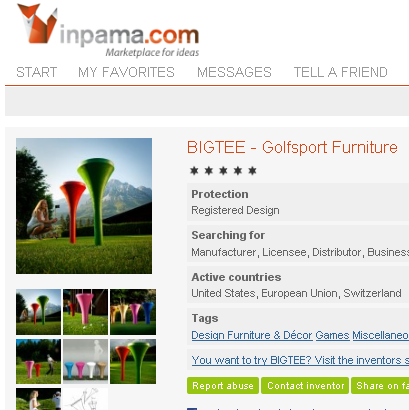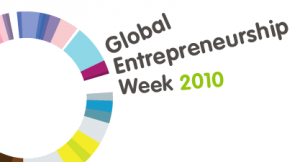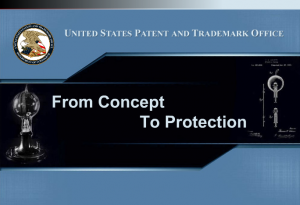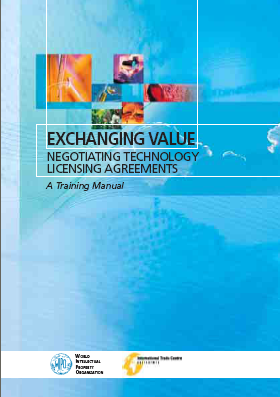Michael S. Neustel, a patent attorney from the United States and founder of the National Inventor Fraud Center, has written a page with information to help guide you through the invention process, particularly in the amount of time an inventor needs to successfully complete an invention. Five phases are defined, starting from invention development and ending at the licensing/selling patent rights phase. Mr. Neustel also provides affordable patent search and patent application services for inventors and small businesses. To view the orignal article, please click here.
Archiv des Autors: inpama
10 ways to protect your IP
Here are some useful tips on protecting your intellectual property, courtesy of the Institute of Directors.
Intellectual Property (IP) theft is surprisingly common. If you haven’t taken steps to protect your logo, designs, trade marks or copyrighted material, there may be nothing you can do to prevent others using it. Find out how to keep your IP safe:
1. List all your IP assets. Ensure that you have a procedure in place to assess and account for your IP, from trade marks and copyrights and designs, to patents and domain names. Use the free IP Healthcheck tool on the Intellectual Property Office (IPO) website to compile a list.
2. Check that your idea is original. Use patent and trade mark searches early in the development of new products, logos and processes to establish whether someone else has got there first and protected them.
3. Record the evidence of IP development. Keep a log of evidence that records the development of your IP. For example, file dated and signed copies of drawings and drafts.
4. Prevent IP theft through contracts. Ensure all your employment and consultancy contracts clearly state your ownership of any IP developed by your firm.
5. Seek advice if you are unsure you are protected. To ensure that any trade mark you create is properly protected, contact a trade mark agent for advice through the Institute of Trade Mark Attorneys. Find a patent agent through the Chartered Institute of Patent Attorneys.
6. Protect your IP early as registration takes time. It can take up to 18 months to get a UK patent granted. However, under a new IPO scheme you can have your UK patent fast-tracked if you already have international approval – reducing the waiting time to two months. Bear in mind it typically takes about six months to register a trade mark.
7. Guard against infringement online. IP infringement has become easier with the growth of internet use and social networking. It happens more than you think — you post a blog or image online and someone else nabs it and passes it off as their own. Copyright and ownership notices will do a lot to put them off, and make it easier to seek redress. Use search engines to check that no one is using your copy, logo or images without your permission.
8. Protect your IP outside the UK. Seek advice on whether you need to protect your IP overseas. Remember you will need separate international patents, design rights and trade marks to protect your IP abroad.
9. Keep an eye out for scams. The IPO has warned that applicants and owners of UK trademarks and patents have received bogus letters from scammers demanding payment in return for registering their details. To avoid falling prey to fraudsters, only deal with official bodies such as the IPO or the European Patent Office when making applications.
10. Be prepared to take legal action. Weigh up whether taking legal action will be worth the expense, but be prepared to pursue offenders for infringement where necessary — sometimes one stiff letter gets results.
November 15-21: Global Entrepreneurship Week
For one week, millions of young people around the world join a growing movement of entrepreneurial people, to generate new ideas and to seek better ways of doing things. Countries across six continents come together to celebrate Global Entrepreneurship Week, an initiative to inspire young people to embrace innovation, imagination and creativity. To think big. To turn their ideas into reality. To make their mark.
From 15 – 21 November 2010, Global Entrepreneurship Week connects people everywhere through local, national and global activities designed to help them explore their potential as self-starters and innovators. Students, educators, entrepreneurs, business leaders, employees, non-profit leaders, government officials and many others participate in a range of activities, from online to face-to-face, and from large-scale competitions and events to intimate networking gatherings.
Through this initiative, the next generation of entrepreneurs are inspired and can emerge. In doing so, they will begin to acquire the knowledge, skills and networks needed to grow innovative, sustainable enterprises that have a positive impact on their lives, their families and communities.
Invention Help Free EBook Released
Many inventors struggle to get their idea developed into a real product that sells. We asked inventor and author, Ron Docie, Sr. to share how to turn an invention into reality. The resulting ebook, “From Invention to Reality: How to Get Your Invention Into Production” is available via a free download at http://www.inventiontoreality.com.
Many inventors worry about people stealing their ideas. Yet at the same time, most inventors never seem to be able to get their invention developed.
This free ebook covers the most common questions asked by inventors. It tells readers how to protect their ideas, the steps of product development, whether to manufacture or license the product and even how to tell if your invention will sell.
These answers come from Ron Docie, Sr who has over 30 years’ experience in getting inventions into production. His own inventions are found in thousands of retail outlets. As an agent for inventors, Docie has negotiated licenses with such companies as General Motors.
From Concept to Protection – a video presentation from the USPTO
Here is a good and informative video presentation issued by the United States Patent & Trademark Office, titled „From Concept to Protection“. Hosted by John Calvert, Administrator of the Inventor Assistance Program and Tony Knight, Supervisory Patent Examiner, the 17-minute long presentation covers explains what to do when you have an idea and how to patent it.
To view the presentation, please click here.
World Intellectual Property Indicators, 2010
Fresh off the press from the World Intellectual Property Organization is the 2010 report on World Intellectual Property Indicators. The 148-page report is filled with comprehensive statistics on worldwide patent and utilility model activity, as well as activity in trademarks and industrial design.
Current trends and outlooks are also identified. Such trends include:
– Slowdown in patent grants worldwide, however utility model activity continues to grow.
– North East Asian countries file the highest number of patents per GDP.
– For the first time, the United States Patent and Trademark Office (USPTO) granted a higher share of patents to non-resident applicants compared to resident applicants.
– The majority of the top 20 IP offices saw growth in the number of industrial design applications, while the majority of the top 20 IP offices saw a drop in the number of trademark applications.
Of special interest is the subreport on „the Impact of Economic Crisis and Recovery on Innovation“.
Some excerpts from the subreport are included here:
 To the extent that investments in innovation such as R&D are long term in nature, short-term fluctuations in the business cycle should only have a limited impact on investment in innovation. However, in the context of an economic downturn, R&D investments and the introduction of new products or processes decline due to reduced cash flows, decreased demand for new products/processes and increased business uncertainty, including uncertainty concerning the size of the future market.
To the extent that investments in innovation such as R&D are long term in nature, short-term fluctuations in the business cycle should only have a limited impact on investment in innovation. However, in the context of an economic downturn, R&D investments and the introduction of new products or processes decline due to reduced cash flows, decreased demand for new products/processes and increased business uncertainty, including uncertainty concerning the size of the future market.
…
As part of their stimulus packages, most governments of high-income economies, as well as a select number of fast-growing middle-income economies, have pledged to avoid cutbacks in science and R&D or to even increase spending.
…
Most major economies have emerged from recession, and many middle-income economies have returned to fast pre-crisis growth rates. The first signs of recovery are also apparent in the greater availability of venture capital since late 2009, and there appears to be a modest recovery in R&D spending. In addition, preliminary data for the first six months of 2010 point to renewed growth of PCT applications.
The crisis is likely to have a lingering impact on IP filing behavior in 2010 and 2011, which – based on lessons from past crises – is likely to be more pronounced for patent than for trademark filings. Thus, while trademark applications are expected to return to healthy growth in 2010 and 2011, recovery in patent applications is bound to be more modest.
The post-crisis world economy is likely to see faster rates of economic growth in low- and middle-income economies – especially in East Asia and India. The corresponding geographic shift of innovative activity, as measured by R&D expenditure and IP filings, that has been ongoing for a number of years is bound to continue. Despite their detrimental effect on revenues and cash flows, economic crises can offer opportunities for rationalization, the acceleration of structural changes, new entrepreneurship and “creative destruction” – elements that are only incompletely measured by R&D expenditure or IP filings. The true overall impact of the crisis and of recovery on innovation – be it positive or negative – is likely to become apparent only over time.
How to market and sell your innovative idea, Part One
Creativity is coming up with ideas, but innovation is bringing those ideas to life. Moreover, an invention is the creation of a new concept, but innovation is turning that concept into a commercial success. As Edison’s famous quote states, “genius is 1% inspiration and 99% perspiration” and this couldn’t be any more true, especially when converting knowledge into money. The following article gives you some ideas on how to proceed turning your idea into money.
You have an idea—what now?
When one has an idea the first step should always be to put it down on paper. In the current age, this page is likely a document on your computer. Over the next few days, your idea will change and expand as your thoughts become stronger and deeper. One can write down points which can be viewed as risks or questions that one has. When the idea is one that can be drawn, one should also produce an outline or sketch. Once your idea is on paper, develop a one-page description of your idea. The end result will create a document that can be shown to a good friend, a patent attorney, or to the patent office.
Patenting your idea
The most widely known proprietary law is a patent. A patent is a legal title which protects a technical invention for a limited period of time (usually 20 years). Moreover a patent prevents others from exploiting the invention within the countries for which the patent has been granted. An invention is patentable when it is:
- new
- commercially applicable
- non-obvious
The invention should be described on the patent application form in such a way that a specialist can understand it. A prototype is not necessary to apply for a patent. The typical lifespan of a patent lasts for 20 years. Fees are also higher if the patent is to be protected in a number of countries.
For further information regarding patenting, it is advisable to contact the patent office of the country you are based in (or wish to patent). An exhaustive link list of worldwide patent offices can be found here: http://blog.inpama.com/?page_id=2
From Patent to Market
Perhaps the most important fact to keep in mind when trying to sell your idea is that the right people learn about your idea. In this case, quality is more important than quality. Define who would be interested in your idea and search them out. You can find future producers or distributors in online company directories. Most companies are waiting for your request. Another useful way to find contact persons of large companies is to use online networks such as LinkedIn. Don’t be shy! Everyone in such a network is basically an open ear. Nothing happens by itself! Get people interested in your idea and send them to your site. There they can see what is on offer.

At every job interview or romantic date, presentation is everything. How does one convey the message that your idea is a good one? This, like in life, is often decided upon the first impression. Express yourself as simple as possible and as technical as necessary, to be equally interesting and understandable to technical and non-technical people alike. The description should be drafted so as to get an overview about what the invention is.
Keep the introductory text of your project page technically simple. Firstly explain what problem your invention solves. More often you do not have to convince just technicians but also marketers! A good photo and the first sentences of the idea description are crucial. One cannot assume that a prospective client will read three pages of text to understand the geniality of the idea. If the client is not interested by the second or third sentence, chances are s/he will move on to the next idea.
To keep your expectations as realistic as possible, here is a rough scale to guide you on what type and how many reactions you can expect. Depending on the quality of your covering letter as well as the target customers you choose, you can expect to receive 3 to 10 responses per 100 attempts. Most of time, you will not get refusals, but rather specific inquiries about prices, technologies, drawings, etc. Answer these questions quickly and thoroughly. A personal interview is particularly valuable. Of course, an inquiry is still no contract, however each inquiry could be just the one that helps bring your idea to the market.
Negotiating Technology Licensing Agreements
As most inventors know, bringing a patented product to market is a challenging task. In the majority of cases businesses are simply not interested in your ideas or see little potential for commercial success. This however is not a rule, as some patents do indeed catch the interest of manufacturers and entrepreneurs.
Let us assume that you are one such inventor who has an idea that has caught the attention of an interested party and are about to enter into talks regarding the sale or utilization of your idea. For the independent inventor this can indeed be a stressful situation as business negotiation is an unknown territory for many. Thankfully there is help out there to provide inventors with the tools necessary for negotiation. One such tool is the World Intellectual Property Organization’s training manual „Exchanging Value: Negotiating Technology Licensing Agreements“.
The 178-page manual provides negotiating guidelines and tips, which may contribute in reaching an agreement which satisfies both parties and enhances the knowledge and skills of the user on all the major issues to be addressed while negotiating such agreements. Such issues and topics include:
- When is licensing the appropriate strategy;
- The importance of diligently preparing for a licensing negotiation
- Methods for valuation of technology;
- The importance of negotiations and the need to seek a „win-win“ agreement.




